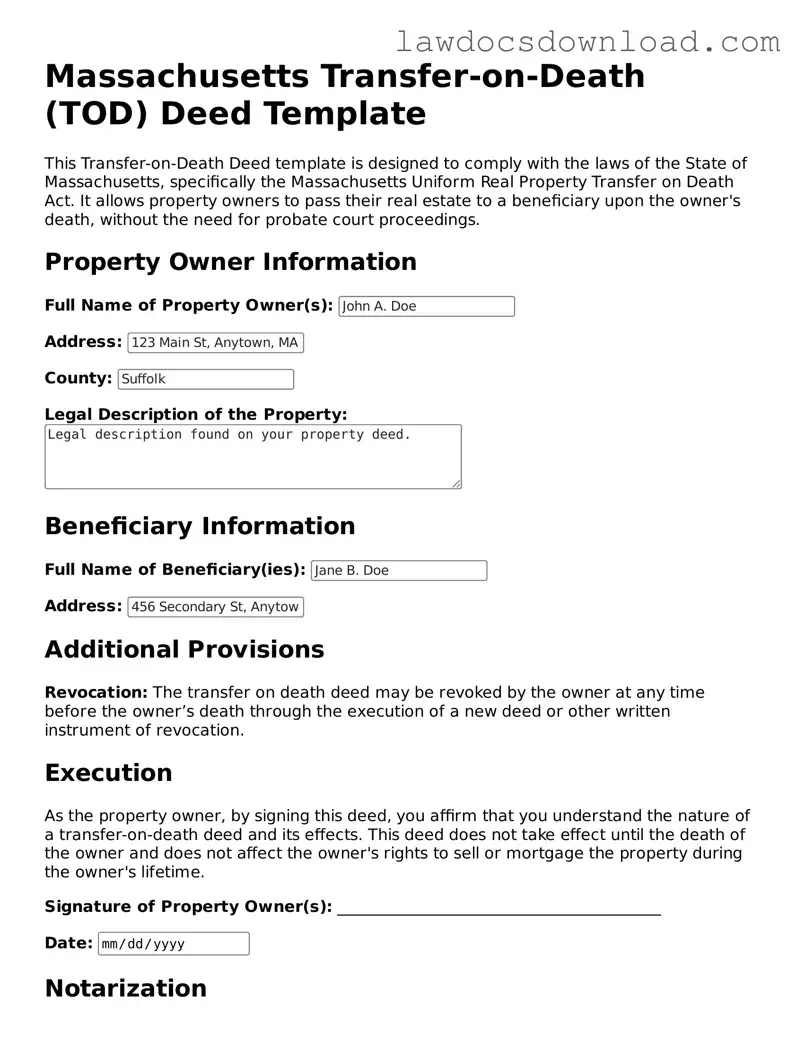The Massachusetts Transfer-on-Death (TOD) Deed form shares similarities with the Last Will and Testament, primarily in its function of designating beneficiaries for a person's assets upon their death. Both documents allow an individual to specify who will inherit their property, although the TOD deed is exclusively focused on real estate while a will can cover a broader range of assets. The main distinction lies in the fact that property transferred through a TOD deed bypasses the probate process, unlike property distributed under a will.
Comparable to the TOD deed, a Revocable Living Trust is created to manage and distribute a person’s assets after their death. The trust allows assets to pass to beneficiaries without going through probate, similar to the TOD deed’s streamlined approach to transferring real estate properties. However, a living trust covers a wider array of assets beyond real estate and involves naming a trustee to manage the assets, offering more control over how and when the assets are distributed.
Joint Tenancy with Right of Survivorship agreements bear similarity to the TOD deed as well, in that they allow property to be passed to the surviving owner(s) without probate upon one owner’s death. This method of holding title to property, like the TOD deed, simplifies the transfer of real estate. However, it differs in that it takes effect immediately upon one owner’s death, without the need for any additional documents to be filed.
The Beneficiary Designation form, commonly associated with financial accounts like life insurance, retirement accounts, and bank accounts, is another document similar to the TOD deed. It designates who will receive the assets in these accounts upon the account holder’s death. Like a TOD deed, it allows assets to bypass the probate process, offering a direct transfer to the designated beneficiary. However, it is limited to specific types of financial assets, unlike the TOD deed’s focus on real estate.
The Durable Power of Attorney for Finances (DPOA) shares some procedural similarities with a TOD deed by allowing an individual to appoint someone to manage their financial assets. While the DPOA is primarily for use while the individual is still alive but incapacitated, it indicates a trust in someone to handle one’s assets, akin to the TOD deed’s trust in a beneficiary to inherit real estate. The notable difference is that the TOD deed comes into effect upon death, not during incapacity.
Life Estate Deeds are akin to TOD deeds as they involve planning for the future transfer of property. With a Life Estate Deed, the property owner transfers their real estate but retains the right to use it during their lifetime. Upon their death, the property directly passes to the remainderman named in the deed. This arrangement mirrors the TOD deed's avoidance of probate, although through a Life Estate, the owner relinquishes control of the property during their lifetime, unlike with a TOD deed.
The Healthcare Proxy is similar to the TOD deed in that it involves designating another person to make decisions on one’s behalf, although this document exclusively relates to medical decisions in the event of incapacity. The similarity lies in the anticipation of future events requiring a trusted individual to take responsibility. Unlike the TOD deed, which deals with property transfer after death, the Healthcare Proxy is effective only during the individual's lifetime under specific circumstances.
A "Payable on Death" (POD) account is a financial arrangement that mirrors the TOD deed’s straightforward beneficiary designation for real estate. In a POD account, the accountholder names a beneficiary to receive the funds in the account without those funds passing through probate. While the TOD deed applies to real estate property, the principle of naming a beneficiary to directly receive assets is a shared feature.
The Quitclaim Deed, while used in different contexts, has its parallels with the TOD deed by providing a means to transfer real estate interest. A Quitclaim Deed transfers the grantor’s interest in a property to a recipient with no warranties regarding the property's clear title, unlike a TOD deed that transfers property upon death. However, both serve the purpose of changing property ownership, albeit under varying conditions.
Finally, the General Warranty Deed, much like the TOD deed, is used for the transfer of real estate. The General Warranty Deed guarantees the buyer that the seller holds clear title to the property and provides warranties against future claims. The connection to a TOD deed lies in their shared goal of transferring real estate, though the TOD deed uniquely bypasses probate by transferring property rights posthumously, without the comprehensive warranties provided by a General Warranty Deed.
